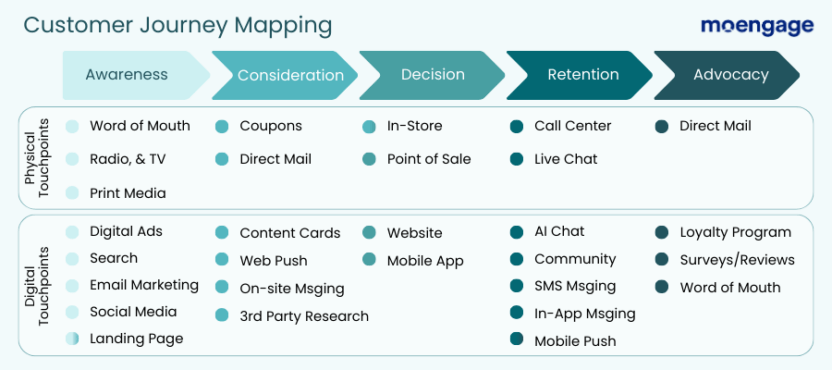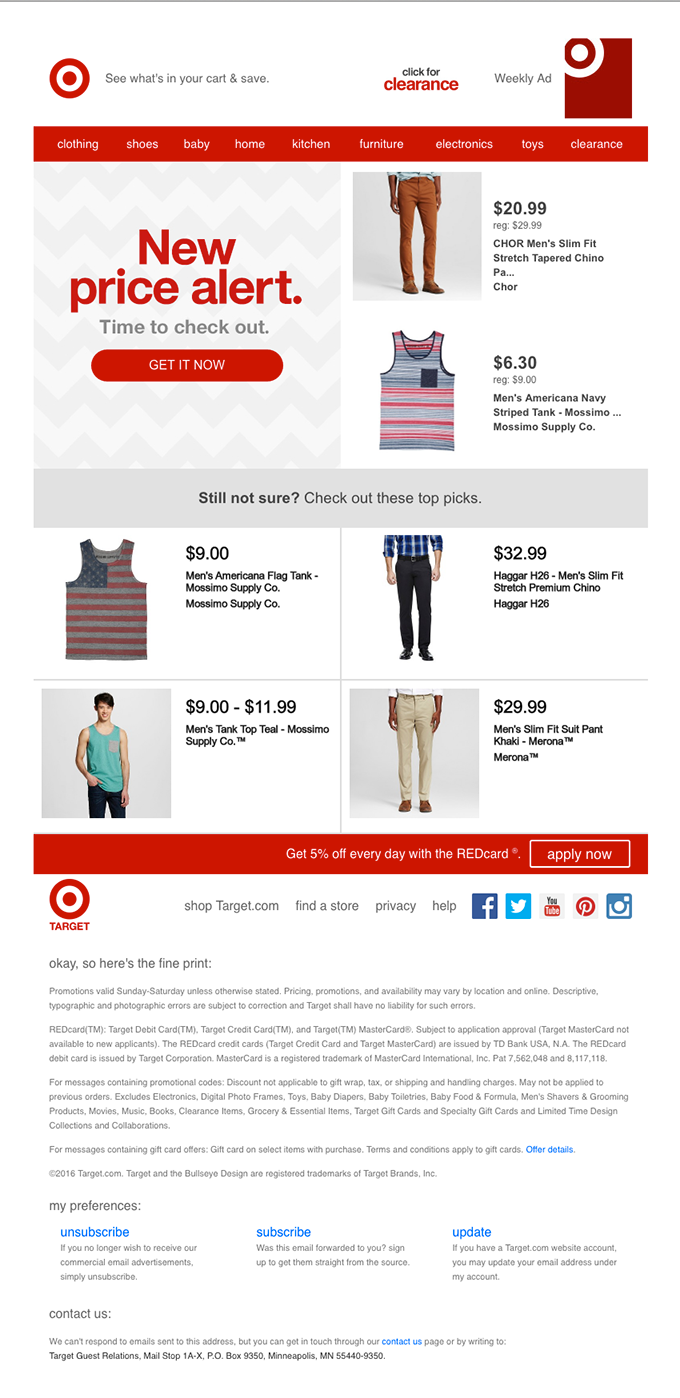Email Marketing Journey Ideas and Examples

Reading Time: 10 minutes
You can’t send your customers the right message at the right time without understanding their email marketing journey.
Imagine you come across a brand on a billboard while driving back from work. You take the effort to write down the brand name, and once you’re home, you search for them online and land on their homepage. You then explore their homepage, look at their products, find the one you like, and make the purchase. You’ve made a purchase within an hour of hearing about the business. Over the years, you keep returning to make more purchases without any nudge from the business. If this happens, you’re the perfect customer for every business. But does it happen? Rarely.
While this is a perfect customer journey, in a more realistic scenario, it takes a long while and usually a few well-placed nudges from the business to get a customer from square one to the finish line. Every marketer needs well-thought-out email marketing strategies to help customers along in the buying process. With many technology advancements today, every marketer is spoiled for choice when it comes to communication channels, but even with all that, a good email marketing strategy still remains effective.
What Is An Email Marketing Journey?
An email marketing journey consists of setting up a series of automated emails throughout a customer’s journey with your business. These email campaigns are aimed at creating a seamless experience for the customer and converting potential customers into long-term loyalists. It takes a customer-centric approach.

A singular marketing email or marketing campaign is not a rare occurrence for customers. For most of us, there are more emails in the promotional folder than in our inbox. Customers are blasted with marketing messages, so your marketing strategy has to stand out. It cannot be generic, one-off email campaigns. This is where email marketing strategy can make a difference. It is tailored around a customer journey map and all customer touchpoints, making it personal and more effective.
Benefits of Implementing a Well-structured Email Marketing Journey
Did you know you can get up to $40 as returns on every $1 spent on email marketing? A good email marketing campaign is built around customer journeys, making it more effective than any other marketing strategy. Here are the benefits of implementing a good email marketing strategy:
- Personalization: Personalized emails are tailored to customer journey maps and critical touchpoints in the customer journey. This ensures that the customer relates to these emails and it adds value to their experience.
- Guided decision-making and conversion: At different points in a customer journey, the customer could hesitate to proceed. Well-automated email marketing campaigns can help answer questions, build trust, and ease the customer’s hesitation to guide them to the next step in decision-making for better conversion rates.
- Build customer relationships: Whether it’s new or existing customers, constant communication is important to build brand loyalty and create long-lasting relationships. With an email marketing customer journey, the communication is periodic and value-adding, which helps build strong customer relationships.
- Reduced sales cycle: A well-timed email during a customer journey can push the customer to make the purchase.
- Good return on investment: Since the email marketing strategy is closely tied to the customer journey, these emails are extremely effective and can yield a good return on investment with high conversion rates.
The Importance of Email Marketing Customer Journey Mapping

What makes an email marketing journey successful is its close association with the customer journey. Customer journey mapping (even for Ecommerce customer journeys) can make or break email marketing campaigns. Every email in the campaign has to be aligned with one of the following aspects:
- Customer journey stages
- Decision-making barriers
- Customer actions and pain points
1. Email Marketing Journey Stages
Assuming a traditional marketing funnel, your email journey should cater to each stage on the customer journey map. Let’s see the different stages of a customer journey and apply them to the real world with an example.
Brand Awareness Stage: This is when you make initial contact with the customer. It’s where they hear about your brand, and you get the chance to gather customer data. At this point, they are still potential customers.
Consideration Stage: This is where they are contemplating making a purchase but need more information about your brand or comparison with competitors to make the decision.
Decision-making Stage: This is the final stage of the buying process. It’s when they’re done with compare-and-contrast and want to purchase from you but need a slight nudge.
Post-purchase Stage: Now that they’ve purchased from you and become customers, this is the stage immediately after they make the purchase, where you can send emails about customer support and product/service onboarding. This stage can be crucial for customer satisfaction with the product and your brand.
Retention Stage: This is where they are your customers, but you still need to use a good strategy and communication to retain them as customers who provide repeat business.
Brand Advocacy Stage: Happy customers are loyal customers, but loyal customers need some incentive. This is the stage of their customer journey when you have to give satisfied customers ways and reasons to become brand ambassadors.
Reactivation Stage: If your business model is not based on renewals or subscriptions, you must re-engage with customers to revive them from their inactive status.
2. Decision-Making Hurdles
There will be hurdles that prevent a potential customer from moving from one stage to another in the overall email marketing customer journey. These hurdles can be of four categories:
- Motivational Hurdles: This is one of the biggest hurdles to overcome. No matter how good your product is, if your customers don’t think that they need the product, they will not move to the next stage. Showing them how your product can help the customer will help them overcome this hurdle.
- Information-related Hurdles: The customer makes decisions based on information that they have. If they cannot find the information they are looking for, they will not move to the next stage. This is a relatively easy hurdle to overcome by providing the customer with helpful information.
- Experiential Hurdles: This hesitation often stems from previous bad experiences with the product or service, even from other providers. It could also be due to poor customer experience on your website or application. It makes the customer hesitant about moving forward. Build a good experience for the customer and show them what’s unique to your brand to move along customer journeys using customer testimonials and customer feedback.
- Temptational Hurdles: Customers today are spoiled for choice. The product or service is provided by multiple brands. The temptation of an upcoming offer from another provider can be a hurdle in moving them to the next stage of the customer journey.
3. Customer Touchpoints
Besides the stage and hurdles, an email journey can also be built around different customer behaviors or customer interactions with your business. Analyze the customers’ actions to understand how they behave when they are happy and when they are not. Once you study the action, you can identify the different pain points. This can help tailor your email journey to the actions and address the pain points that encourage customers to make quicker decisions.
How to Map Your Email Marketing Strategy to the Customer Journey

First things first, you need to tailor your email marketing strategy to the different stages of the customer journey. This requires careful planning and implementation.
Understand Your Customer
Understanding an existing customer, past customer, or new customer is the first step toward the email journey mapping process. You can collect data through surveys on your platform, generating new subscribers for newsletters, gated content, purchase history, engagement patterns, and more.
Segment Your Customers
The next step is to gather insights from the data you have collected. By analyzing customer data, you will be able to draw up a relevant email marketing customer journey for each of these different customer segments. You can segment customers based on their customer profiles and other demographics, psychographics, and behavioral profiles.
Define Goals For Touchpoints
Once you have the segments, you must define the different touchpoints at which you will send out email campaigns for each segment. You must also define the goal you wish to attain from the email marketing efforts.
Personalize Every Email
Email campaigns in the email journey cannot be generic. With different segments involved, a one-size-fits-all approach does not work. Email strategy has to differ for each segment, and brands should go beyond first-name personalization. The emails in the customer’s journey have to be tailored for the goal, touchpoint, and segment.
Leverage Omnichannel Communication
Don’t rely on email marketing as your only touchpoint with your customer. Use other channels, such as website personalization, SMS, push notifications, transactional messaging, or even in-app nudges, to communicate with your customers.
This omnichannel approach ensures that customers are engaged across channels that are relevant and moment-based.
Best Timing for an Email Marketing Customer Journey
Now that we have the customer journey mapping and the personalized content ready, the next step is to figure out the best time to send emails. Automated email campaigns are more effective and efficient since they can be sent out at the right time in an email customer journey and used to nurture customers. Leverage a reliable marketing automation tool to automatically figure out when customers need to receive email campaigns down to a personalized level.
Analyze and Measure Every Email Marketing Journey
Email marketing journey mapping is just one part of the puzzle. Once everything is in place, it is important to analyze the process and measure how the email journey is performing so it can be optimized. Use avenues like surveys, social media platforms, and customer support conversations to gauge the effectiveness of your campaign. You can rely on key metrics like open rate, click-through rates, bounce, unsubscribes, and conversion to quantify the success and use these insights to optimize the campaign.
Examples of Lifecycle Campaigns
Here’s a look at some emails that can be sent to achieve the goal at each stage in the email marketing journey, along with examples:
1. Awareness Stage
Goal: Engage with the customer and promote your email program
You can build brand awareness by sending content that the customer will find useful. Reflect the same in your subject line. This will encourage recipients to become regular email subscribers and engage with your email. Here are the emails you can send during this stage:
- Compelling welcome emails with a brand story
- Onboarding emails which make the experience seamless
- Informative and sharable educational content
Take a look at the examples below.
Beardbrand: Share your brand story

King Arthur Flour: Sell the experience

2. Consideration Stage
Goal: Show customers why you’re the right choice
Create personalized content to address customers needs and show how your product can be useful. Show them why you’re the right choice by including this information in your emails:
- Welcome emails with social proofing
- Customer stories
- Comparisons with competitors
- The unique selling point of your brand
- Personalized recommendations
Take a look at the examples below.
Pulp&Press: Center stage to social proof

Three nails: Colorful customer testimonials

3. Decision-Making Stage
Goal: Giving customers the last push they need to commit
The content of the emails in this stage should be enticing enough to convince a customer who is hesitant to cross over:
- Limited-period offers
- Statistics about the effectiveness of your product/service
- Cart abandonment email
Take a look at the examples below.
Rudy’s: Creative and witty cart abandonment

Chatters: Create urgency with cart abandonment

Post-purchase stage
Goal: Ensuring that the good customer experience extends beyond purchase
The post-purchase experience is as if not more important than before purchase. This decides if the customer will be retained or not. The key to this is great support and well-delivered transactional emails:
- Transaction confirmation
- Post-purchase follow-up
- Easy way to contact customer support
Check out the examples below.
River Island: Clear order confirmation

Postable: Fun shipping notification

4. Retention and Re-engagement Stage:
Goal: Make sure that the customer keeps making purchases with you
Both for customer retention and re-engagement, the key is to keep the customer engaged and updated on enticing offers and discounts.
- Re-engagement campaign based on purchase history
- Loyal customer engagement
- Upsell/cross-sell using personalized recommendations
Grammarly: Display effectiveness to upsell

Target: Re-engagement offer using purchase history

Customer Journey Email Best Practices
Following the steps and techniques mentioned in this article will help you create an effective email marketing journey for your customers. There are some do’s and dont’s outside of these that can perfect the process.
Things to Avoid
- Overwhelming the customer: It is tempting to send out emails for each touchpoint that seems relevant to you, but it is more important to know when to stop. Spamming the customer with a stream of marketing emails will frustrate the customer and achieve the opposite of your goal.
- Misleading subject line: Click-baiting the customer with irrelevant subject lines is a terrible look for a business and is sure to prevent the customer from wanting to engage with your brand.
- Making assumptions: Always base your email journey on data. Using assumptions to tailor content can lead to irrelevant and ineffective email campaigns.
- Negating feedback: Even if you think you’ve gotten everything right, it is important to optimize your email journey based on customer feedback constantly.
Things to Remember
- Deploy proper email authentication: Use email authentication protocols like SPF, DKIM, and DMARC to improve the deliverability of your emails to your customers.
- Never purchase a mailing list: Build an engaged subscriber list and find a way to keep it up-to-date and relevant.
- Optimize for different devices: Your emails are often accessed by customers on the fly. Ensure that your emails are optimized for different devices, clients, and browsers.
- Tools and software: Use email marketing tools and software to help execute the email journey you have created. This will optimize your time and resources and improve the accuracy of your campaign.
Meet Your Customers at Every Email Marketing Journey Stage with MoEngage
An email marketing journey is a key piece in attaining the conversion rates and revenue that you aim for. It is one of the most common forms of communication with customers. When done right, it can give amazing results, help you collect customer feedback, and build long-lasting, fruitful customer relationships.
Speaking of journeys, MoEngage is an all-in-one email marketing platform that helps you engage with your customers at every stage of their email marketing customer journey. It doesn’t just help you collect data through embedded forms on landing pages. You can also segment your customers and automate your email campaigns to send them hyper-personalized emails at the right moment.
Take an interactive demo today to start reaching your customers where they are in their respective journeys.














